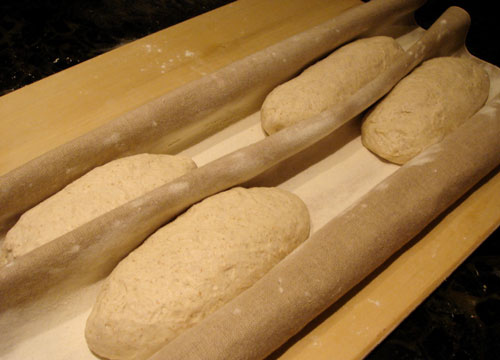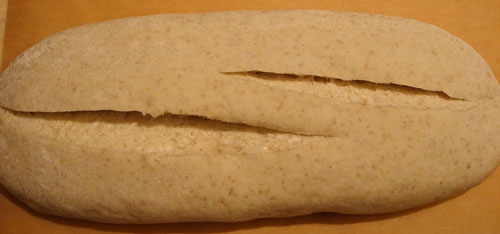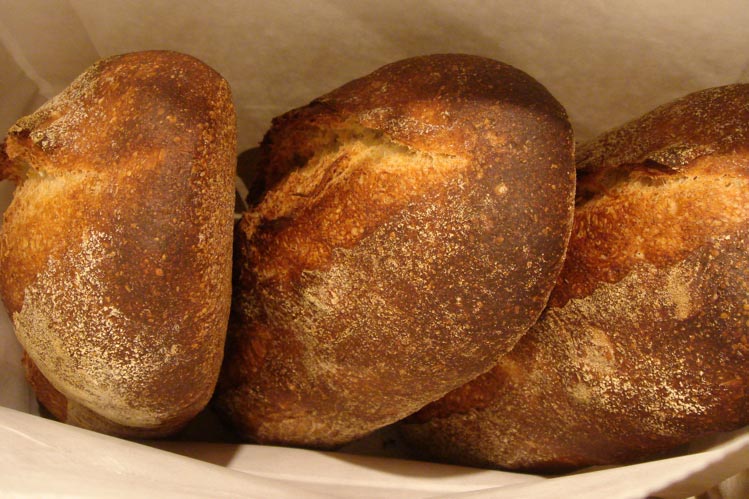
Can anyone please help with my after slash deflated dough?

I have followed the recipe below, but I have increased the hydration to 70% instead of 65% then I have added another stretch n fold.
in bulk fermentation it doubled its size. In second proof it has doubled when I slashed it, it deflated and didnt give me any oven spring at all. The crumb now is very gelatinised and densed. Did I overproof it or slash it too badly? N my oven can only hit 220 max not sure if that matters.
Thank You!!!
Norwich Sourdough
(adapted from Vermont Sourdough in Bread: A Baker’s Book of Techniques and Recipes by Jeffrey Hamelman)
Yield: 2 kg (four or five small, or two large, loaves)
Time:
Mix/autolyse: 35 minutes
First fermentation: 2.5 hours
Divide, bench rest, and shape: 20 minutes
Proof: 2.5 hours (or 1.5 hours, then retard for 2 – 16 hours)
Bake: 35 minutes
Desired dough temperature: 76F
Ingredients:
900 g white flour (I used Heartland Mills unbleached malted all-purpose)
120 g whole rye flour (I used KAF pumpernickel)
600 g water at about 74F
360 g mature 100% hydration sourdough starter
23 g salt
Method:
- In the bowl of a stand mixer, mix the flours, water, and starter on low speed until just combined, about one minute.
- Let the dough rest (autolyse) for 30 minutes.
- Add the salt and continue mixing on low or medium speed until the dough reaches a medium level of gluten development. This should only take about 3 or 4 minutes.
- Transfer the dough to an oiled container (preferably a low, wide one so the dough can be folded without removing it from the container).
- Ferment at room temperature (72F – 76F) for 2.5 hours, with folds at 50 and 100 minutes.
- Turn the dough out onto a lightly floured counter. Divide it into 400g – 500g pieces. I usually make four 400g loaves and refrigerate the rest to use for pizza dough later. Preshape the dough pieces into light balls.
- Sprinkle the balls lightly with flour, cover loosely with plastic, and let rest for 15 minutes.
- Shape into batards and place seam-side-up in a floured couche or linen-lined bannetons.
- Slip the couche or bannetons into a large plastic bag or cover with plastic wrap and proof at room temperature for 2 – 2.5 hours. Alternatively, the loaves can be proofed for about 1.5 hours at room temperature, then refrigerated for 2 – 16 hours and baked directly out of the refrigerator; this will yield a tangier bread with a lovely, blistered crust.
- Meanwhile, preheat the oven, with baking stone, to 475F. You will also need steam during the initial phase of baking, so prepare for this now.
- Turn the proofed loaves onto a semolina-sprinkled peel or parchment. Slash each one with two overlapping cuts that are almost parallel to the long axis of the batard.
- Once the loaves are in the oven, turn the heat down to 450F. For 400g loaves, bake for 12 minutes with steam, and another 15 – 18 minutes without steam. I leave the oven door cracked open a bit for the last 5 minutes of this time. The crust should be a deep brown. Then turn off the oven and leave the loaves in for 5 minutes longer, with the door ajar, to help them dry. Larger loaves will need to be baked longer.
- Cool on a wire rack. Don’t cut until the loaves are completely cool, if you can manage it!
- See more at: http://www.wildyeastblog.com/2007/07/08/my-new-favorite-sourdough/#sthash.4qbhKqdz.dpuf
- See more at: http://www.wildyeastblog.com/2007/07/08/my-new-favorite-sourdough/#sthash.4qbhKqdz.dpuf





might have sped up the fermentation resulting in a slightly over-proofed dough.
Hard to say, but deflation after scoring is hinting strongly at over-proofing. Your comment, "In second proof it has doubled when I slashed it." is also too much rise, keep the rise closer to 3/4 or less than double leaving some room for oven action. A free standing loaf is hard to judge expansion but if you pinch off a tiny ball of dough and gently press it flat into a shot glass, it is easier to watch the rise.
Might be interesting to make it again and not score, relying on the wetter dough to stretch more without scoring. Changing the hydration would mean more folds earlier during yeast growth. The wetter dough will relax sooner and need more structural support.
If shortening the bulk rise does not help, try to slow down fermentation try using cooler water in the recipe.
Two methods are mentioned in the recipe, which method did you use? The room temperature rise or the refrigerator rise? (and for how long?)
thank you for your comment.
But its really hard to eye ball the rise especially when its free standing. Coz I tried the poking test, it went down and bounce up with a dent, but at the same time i can see there are irregular air bubbles on the surface of my dough. Its really confusing.
Like you said pinch off a tiny ball of dough is very useful but how should it look when its double?
Actually I have lengthen the bulk rise >< I did 3 in bowl folds at 45, 90, 135 after the last fold i let it rest for 20 minutes before shaping.
I have used the room temp fermenting method (but my room temp is around 30C) Im not sure how long but it should be around 2 hours (I guess thats too long as well). Now I have another dough in the fridge fermenting. I think by the time i arrive home from work it would have been fermenting for 26 hours. Would that be too much as well?
shows a satisfactory and even crumb. The bottom crust does look a little bit light, perhaps more heat under the loaf is needed. I certainly wouldn't be making drastic changes with each bake as I think you are very close to your goal. :)
Out of curiosity, what happened when you used the 65% hydration in the recipe?
What is your set up with the oven and what color are your baking surfaces? Sometimes a switch to a dark baking surface and/or flipping a lipped baking pan upside-down is enough to tip the bake into the right direction getting more heat & thus more lift in the first 15 minutes.
Try baking the chilled 26hr dough and see what happens. Dough rising slower in the cold fridge, temp. does make a big difference. Score just deep enough to break the dough surface "skin" and hold the blade almost flat to the loaf surface, more like you want to lift up the "skin" on one side of the cut.
Getting back to the first loaf... during the room temp. bulk rise and the folding... did you note any significant rising in the dough between folding? If not, it could be that the dough just hadn't risen enough. If the dough seems too dense while shaping, count it as a fold and let it rise more, after it puffs up a bit, shape it. I tend to think of sourdough as a continuous rise with a rather short rise after the final shape; the long bulk rise is interrupted by folds for strength. This differs greatly from basic yeasted dough.
Your results may vary but I find a long final warm room temp rise not helpful with wheat sourdough. If my final rise (at 30°C) takes longer than the last pause between folds, I stretch & fold it gently (ending in shaping) to distribute food, pop large bubbles and feel how the fermentation is loosening the dough matrix, most importantly fold it again to give it a better shape while it ferments and builds height trapping gas. As the dough ferments it will also feel wetter and rise faster so I do have to estimate when the dough may no longer be workable/shapeable as it ferments towards becoming ripe sourdough starter.
The crumb looks ok to me but the problem is its extremely gummy and quite sour. Its very different to the sourdough bread I used to have.
I havent tried 65% hydration coz Im more interested in a open crumb bread.
My baking stone is beige color would that be problematic? Its quite difficult to find a baking stone in HK.
When I baked my retarded loaf last night it didnt give me any oven spring rather it spread out, the crumb is more open but the texture is still very GUMMY + SOUR! I leave the dough in a 30C for about 1.5 hours to take off the chill then proceed as normal. This time I put the baking stone on the lowest rack, trying to heat it up a bit more. According to my oven thermometer, the oven temperature is around 400F.
From the start to first fold, the size of it is 80% towards double, first to second fold it has doubled, after the third it puffed back to double. Could that be the gluten not developed properly? N the dough is very sticky during the shaping I have added fair a bit of flour to keep it from sticking to the bench.
I didnt stretch and fold it during the shaping process, rather I spread it out in a rectangle shape and do the shaping.
That sounds like work needs to be done to boost yeast numbers and reduce the bacteria in the sourdough starter. When the starter is working well, the recipe should work better. Everything will then fall into place. Shaping folding stone, etc, it all sounds fine to me.
I suggest putting the recipe on hold for a few days and work on the sourdough starter.
Omg!
could that be when I fed it twice, I had a twelve hours interval at my very warm room temperature which caused the problem? I saved a cup of starter and feed it again then put it in the fridge and it is still growing.
Can you please suggest what I could do to save my starter? and is it necessary to feed it twice, let it double and use it while it still is?
i know I have asked so much question, I really appreciate ur help. thank you!!
Also the starter collapsed before i used it. Could that be the problem as well?
don't change what you are doing and just tell us about your standard starter maint. procedure.
I'm afraid to write too much without knowing how you maintain your starter but I will be very busy the rest of the week. There is lots of info here at TFL.
Refrigerated starters tend to get out of balance slowly swinging in the direction of too much bacteria to yeast. Can easily happen if the starter is not permitted to rise and fall a few times (go thru complete cycles) to boost yeast once a month. When you notice the starter slowing down or making a lot of sour and heavy loaves, it's time to boost the yeast count. Baby it for a while to get lots of activity.
All you have to do is keep the starter at room temp for a few days. Take a rounded teaspoon (10g) of starter and give it 50g water and 50g flour, place in a tall narrow glass to mark and watch, cover and let rise to peak and start to fall back. Then repeat. (Keep your old starter around as a back up at the back of the fridge until your boosted starter proves itself in a loaf.) Keep track of how long it takes and it should rise higher and faster each time you repeat a feeding. The starter should reach its first peaking between 6 and 12 hrs. for an average starter. Feeding more often as or just after it peaks will help your yeast numbers catch up. When you decide to chill again, let the starter first show signs of life, or about 1/3 risen before chilling it. This ensures the yeast are working before slowing them down. Good Luck.
I received the dried starter recently from CarlsFriend and I followed the instruction to revive the starter. Then it slowly rise in the fridge.
I use the starter to bake my first sandwich loaf right after I feed it with 1:0.5:0.5 Starter:water:Flour, but that one I cheated with a bit of yeast so it didnt cause any trouble like this one.
Before I bake this loaf, I bring the starter to room temp and fed it using the ratio above every twelve hours and i can see it has boom to double and starting to fall back each time, I fed it with the same ratio one last time before I start baking.
So Im going to baby it as per your instruction for the next few days. But is it possible that I leave it at room temperature for too long that would kill it (coz i cant watch it all day) ><?
but an active starter (once the yeast wake up and get active) needs to be fed more food. A starter should be fed at least equal amounts of starter to flour but with the warm room temps, you can feed a ratio as one to ten! Feed 1 to 5 first and see what it does. then make the next feed bigger, a one to 10 feed. Let it chew on that for a while. There is no danger of killing the starter with those temps and ratios in a 24 hr period. When the starter peaks, use all but 20g of it for a loaf. Feed the 20g, 100g flour and 100g water, let rise about a third and then chill.
If barely feeding it, you can starve it into protest (which sounds like this could happen if allowed to ferment in it's current state without adding any flour.) When the survival of the yeast is threatened (from starvation) it will spore and lie dormant, dormant for days even when fed enough food and water. That would then require patience and waiting without discarding until the yeast shows itself again.
Thank you so much. Now i can see what I did wrong last time. Is very lucky that you found the problem. Otherwise very likely Im gonna starve my little babe to death.
I did a 1:5:5 feeding last night in less than 10 hours it has almost tripled itself. Should I keep feeding it?
Im gonna give it 1:10:10 see what it gives me. Hopefully I can use the starter this sat for baking. If I let it sit at room temperature for over 24 hours could that be a problem?
Thanks you so much, your generous help means a lot to me!! Thanks again !!
baking with it.
Yes, another feeding would do it good. and you can easily give it 24 hrs with a 1:10:10 feeding or go for 1:15:15 to be sure. But if you are around and the 1:10:10 is doubled, and still peaking or almost peaked, shove into the fridge to use directly on Saturday morning. Even if it falls in the fridge it will be stronger than it is right now. Warm water on Sat should balance out the dough temp.
I have fed it with 1:10:10 this morning. I should be able to catch it when I peaks tomo morning before I head to work :) would it be better if I put it in an a/c room for the last 12 hours? to slow it down a bit?
btw would the starter still be ok even it smells a little bit like alcohol?
Thank you very much !!!
ps I've made some sourdough pancake this morning with the discarded dough :)